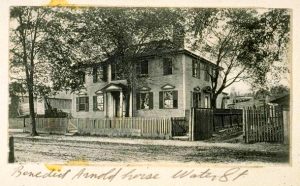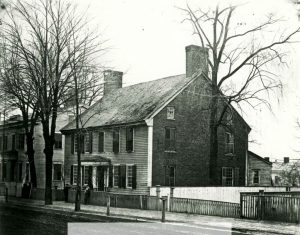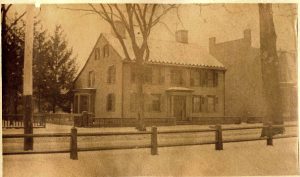This story is the unfortunate flip side of “Top Ten Revolutionary War Patriot Homes in Connecticut”: the most significant Connecticut houses demolished in the 1800s or 1900s. Not included, of course, are the plethora of homes burned by the British in their raids on the Connecticut coast, including New Haven and Fairfield, in July 1779; Fairfield alone lost some seventy houses. Those listed below survived well into the nineteen and twentieth centuries, one as recently as 1964.
Benedict Arnold House, Norwich
Benedict Arnold was born in the port city of Norwich in 1741 to the locally distinguished family of Benedict Arnold Sr. and Hannah Waterman Arnold. The father’s success as a merchant turned to sadness and failure as several childhood deaths of Arnold’s siblings largely caused his father to become an alcoholic. It is somewhat amazing the Arnold House survived being burned by a mob after locals disinterred the father’s remains and threw them and his headstone in a local river following Arnold’s exposure as a notorious traitor in September 1780. The Arnold home was located in the Norwichtown section of the city and the site is marked by the adjacent side street Arnold Place, as well as a plaque. Benedict Arnold, embarrassed by his father’s fallen reputation, moved to New Haven around 1762.
Benedict Arnold House, New Haven

It was in the Elm City that Arnold became a wealthy merchant, opening a general store that included books sold to students at Yale. Around 1765 he hired distinguished architect Peter Harrison, who had designed the stately and famous Touro Synagogue and Redwood Library in Newport, to design a stately home on Water Street, close the wharf where Arnold traded goods. The Colonial Dames series on houses in Connecticut, published in the 1930s, indicates the house featured fine woodwork, fireplaces, and an orchard and gardens behind the house. Arnold’s house survived into the early twentieth century as a wheel shop.
General David Wooster House, New Haven

When the British conducted a raid on the Patriot supply depot at Danbury in April of 1777, resulting in the Battle of Ridgefield, two patriot leaders from New Haven responded to the alarm: Generals Benedict Arnold and David Wooster. Born in 1710, Wooster had already seen combat in several campaigns as a field officer in the French and Indian War and led soldiers in the invasion of Canada in late 1775. Following his resignation as a brigadier general in the Continental Army, he served as a militia major general and was mortally wounded at the Battle of Ridgefield. He was buried in Danbury, where a large Masonic memorial about forty feet tall was erected in his honor. Not much is known about his stately Georgian home that was located on Wooster Street in downtown New Haven, which thankfully was photographed by Willis Butricks in the 1890s.
Signer Roger Sherman House, New Haven

Another historic house in downtown Elm City at what is now 1032 Chapel Street near the city green was the second house of Roger Sherman, the only man to add his signature to all four key founding documents. He also, along with the help of Oliver Ellsworth, created the “Connecticut Compromise” in 1787, which advocated creating a House of Representatives based on a state’s population versus a Senate with two senators for each state. During his 1789 tour of New England, President Washington noted in his diary that he had tea on October 18 at the home of Sherman, who was then serving as the city’s mayor. The house was tragically demolished about one hundred years ago, and a stately building was erected in its place, which has been home to the famous Union League Cafe for decades. Sherman’s home site is remembered with script on the formal, wood mantel on the first floor.
Beers’s Tavern, New Haven
Arnold, Wooster, Sherman and other patriot leaders of New Haven often met at the historic, aptly-named Beers Tavern located at the corner of what are now Chapel and College Streets at 900 Chapel Street. It was owned by Isaac Beers beginning in 1754, and it was here, on April 20, 1775, that Benedict Arnold, famed captain of the Governor’s Foot Guard, rode his horse up to the tavern door, backed by the Guard. He demanded that the town selectmen hand over the keys to the powder house so he could arm his troops and march to the Boston area in response to the battles of Lexington and Concord. He was successful and they marched to Cambridge.
George Washington, newly commissioned as the commander-in-chief of the Continental Army, stopped overnight at Beers Tavern on June 28, 1775, along with his adjutant general, Horatio Gates. The following morning Washington inspected about one hundred Yale students who assembled in front of the tavern, armed and ready for battle. Among them, plying a fife, was Noah Webster, creator of the first American English Dictionary.
The tavern was demolished in 1848 to erect a hotel. Today the site is occupied by the former Taft Hotel building, and includes the fine Ordinary Bar, a restaurant that displays the early history of the site, including the Beers Tavern and the Arnold and Washington history on its walls.
Roger Sherman’s House, New Milford
Before Sherman moved to New Haven, he lived in a house on the green in the center of New Milford. Little is known about the house, but it was demolished to make room for the Town Hall. Sherman moved to New Milford from eastern Massachusetts in 1743. It was here that he opened the town’s first store. Despite the fact that Sherman had no formal legal training, he read for the bar exam and was admitted to the Bar of Litchfield, Connecticut in 1754. He represented New Milford in the Connecticut House of Representatives from 1755 to 1758 and 1760 to 1761.
Brigadier General Jedediah Huntington’s House, New London
Whereas most of the houses in this list were demolished in the early 1900s, the tragedy of Huntington’s house in downtown New London was that it stood until the late 1950s. It finally fell victim to the horror of the then-popular urban renewal program underway in many of small cities of the United States in that era.
While Huntington was a Norwich resident, in 1789 President Washington appointed him collector of customs at the port of New London. Inspired by Washington’s famous estate in Virginia, Huntington called his stately home “Mount Vernon.” It was at Huntington’s house that Lafayette visited during his grand tour of the eastern states in 1824, much like he visited Huntington’s first house in Norwich during the American Revolution. Oddly enough, local lawyers did not think to make the stately “Mount Vernon” mansion into law offices, given that it was across the street from the 1786 New London County Courthouse that still stands and operates.
Colonel Phineas Burr Bradley’s House, Ridgefield
A first cousin of Vice President Aaron Burr, Colonel Bradley was initially a Loyalist-leaning judge who became a patriot at the outbreak of war in 1775. He was commander of the 5th Connecticut Regiment, which distinguished itself in many battles and campaigns including the Battles of Germantown and Monmouth. Bradley’s regiment also suffered during the long, difficult winters of 1777-1778 at Valley Forge and 1778-1779 at the Redding, Connecticut, encampment.
Bradley was one of the patriot commanders who responded to the British raid on Danbury in 1777. In fact, Bradley’s house on Main Street in the center of Ridgefield was witness to a part of the battle. The two-story Georgian home had a most bizarre twist that ended its existence: the elderly woman who owned the home in 1964 donated her property to the Town of Ridgefield to create Ballard Park, but only on the condition that the house be razed, which of course it was.
Major General Samuel Holden Parsons’ House, Middletown

General Parsons is probably the most obscure major general in the Continental Army in the American Revolution. His legacy is forgotten partly because he had no famous experiences on the battlefield. His regiment fought in the thick the infamous fiasco of the Battle of Brooklyn in 1776 and he organized the failed whaleboat amphibious attack on Long Island in August 1777 led by Col. Return Jonathan Meigs. In the fall of 1780 Parsons was among those generals who sat on the board of officers that convicted Maj. John André of being a spy. He resigned in 1782, and would serve as the first president of the Society of the Cincinnati in the State of Connecticut.
Little is known about Parsons’ house in downtown Middletown, an inland port on the Connecticut River where Parsons excelled as a merchant. What adds to the obscurity of Parsons is that no portrait exists of him, and he tragically died relatively young, in his late forties. While serving as director of the Ohio Land Company, he made the long trek to western Pennsylvania, where he drowned while canoeing in a river in November of 1789. He is interred in an unmarked grave near the river, the location of which, due to a series of mishaps, has been lost.
Colonel Jeremiah Wadsworth’s House, Hartford
Colonel Wadsworth was a very wealthy merchant involved in the trade between Connecticut and the Caribbean before, during and after the American Revolution. When Congress reorganized the supply system, he became commissary general in April 1778, resigning in December 1779. Reaching the rank of colonel, he became commissary for Comte de Rochambeau’s army until the war’s end. In the summer of 1783, he went to Paris to report to the French on his activities. He was also close friends with Maj. Gen. Nathanael Greene, and had an affair with widow Caty Greene after Greene’s death.
Wadsworth’s house on Main Street in downtown Hartford was used in September 1780 as the site of General Washington’s conference with the Comte de Rochambeau. This was Washington’s last experience before learning of the treachery of Arnold upon his return to West Point. Wadsworth and his eldest son, Daniel, were painted by John Trumbull. Daniel became friends with Frederic Church, and moved his boyhood home across the street to create room for the first public art museum in the United States—the Wadsworth Atheneum. The house was demolished around 1885 to erect a commercial building. Two monuments pay homage to Washington’s conference with Rochambeau, including a large stele that stands adjacent to the Wadsworth Atheneum. It was erected in 1932 by the Connecticut Daughters of the American Revolution in commemoration of the 200th birthday of Washington.








17 Comments
Excellent article!
May you please write back to me with the exact location of both the Benedict Arnold house & David Wooster house in New Haven?
I was unable to find the site of the former when I was there; I heard varying locations.
It would also be interesting to see where the British were during the raid on New Haven, some troops came up through W Haven while the others landed by Fort Nathan Hale.
Thank you.
Thanks Chris! Good question. I know the Arnold House was on Water Street. Take a look at this video link: https://vimeo.com/9596913
As for Wooster’s house location, I frankly don’t know.
Researched location of Wooster House in photo, it says was located south side of George Street facing College Street.
Great article! I live in Sherman, CT, part of New Fairfield until 1802. It was named for Roger Sherman as he had a cobbler shop in the northern part of town. A developer tore it down, but fortunately the historical society scooped up the remains and rebuilt it in the center of town.
Thanks! I had no idea about Sherman’s cobbler shop; that is great news.
From what I have told by the town historian, Roger Sherman’s house in New Milford is standing, granted in what looks like rather sad shape. It was not torn down, but was moved down Church Street which runs along the side of the present Town Hall and located across Rt 202. It has been added on and has brown shingle siding and a two story porch on the main section of the house.
Wow, Michael, thanks for sharing. Having been a former resident of New Milford for about five years, and nearby, up on Lake Waramaug in Washington, CT, I had no idea. This is the first I’ve heard of it, so thanks for the heads up. I must have driven past it dozens of times. I wish I could visualize which house it is.
It was great to see the houses of 2 very prominent Freemasons. General David Wooster the father of Connecticut freemasonry and Benedict Arnold, both members of Hiram Lodge No.1 in New Haven. Great job Damien.
The Roger Sherman house in New Milford, Ct still stands on East Street a short distance from the town hall and the houses original site. It had been added onto in the mid-1800s with a 2 story addition.
Benedict Arnold’s house in New Haven was on the corner of Water Street on the east side of the junction with Wallace Street. Water Street at that time was directly fronting the harbor shoreline. Wallace Street at that time intersected Water Street but has since been sectioned and the old street itself is now under the northbound I-95 highway overpass. The precise location of the Benedict Arnold Mansion on Water Street today is directly under the eastbound Oak Street Connector as it looms overhead before it intersects northbound I-95. The corner of East and Water streets used to funnel into Bridge Street, now Forbes Avenue which crosses the Quinnipiac River. For reference, see Plan Of New Haven, surveyed by Amos Doolittle in 1817, with a link provided below. If you enlarge the image of the map you can see the mansion at the intersection as surveyed. The map itself is at the Library Of Congess in Washington, D.C.
https://www.loc.gov/resource/g3784n.ct002222/?r=0.327,0.439,0.472,0.194,0
As to the whereabouts of the English army following the Gen. William Tryon Raid on Connecticut coastal towns in July 1779, the primary encampment was on the New Haven Green.
Thank you for that helpful info., Alan. That map of Doolittle is certainly impressive for its detail. As you may know, Doolittle was a talented engraver who is sometimes referred to as “the Paul Revere of Connecticut.” I would love it if you happen to know the whereabouts of Doolittle’s house and if a picture or painting of it exists. Regards, Damien
I enjoyed this article very much because I like old houses, but never want to own one. I rented a 1743 house in Surrey County, Virginia once and it cured me of the desire.
I hope Damien or someone else will provided us with similar articles for other states. Thanks.
Interesting article as I am from CT. Some corrections to the Benedict Arnold House on Water Street in New Haven. All sources are from New Haven Historical Society Library.
1. It is not located on the corner on Water Street. Instead it is located about the middle of the block between Union Street and Olive Street. This is confirmed by multiple maps from the New haven Historical Society including Doolittle’s Map of 1824, Real Estate Map of 1911, Wadsworth Map of 1748, Henry Townshend Map of about 1869, Real Estate Map of 1888.
2. The date of its construction is given by various writers or newspaper articles as between 1767 and 1771. The land for the house was sold to Arnold by his father in law Samuel Mansfield. According to one writer, Mansfield sold the land only to Arnold in 1771. Perhaps the 1767 date comes from marriage of Arnold to Margaret Mansfield.
3. The Arnold House was sold by “Public Vendue” on April 14, 1782. Per Newspaper article.
4. From 1802 to 1812, the house was owned by Noah Webster.
5. 1869: sold to Beckley Lumber Co. Per New Haven City Directory.
6. 1894, New Haven Register: “it was one of the notable houses of the city, but for years has been used as a tenement house and lumber yard.”
7. 1904, Newspaper headline: “A Few Days Will See the End of Mansion in New Haven…” Refers to Arnold House.
8. 1911: Real Estate Map shows a vacant lot on Water Street labeled “Formerly the site of the Benedict Arnold House.”
9. 2017, Info on Assessors Tax Cards: 155 Water St owned by United Illuminating Co used as a substation but in the process of being demolished. Roughly the site where Arnold house was located. Vacant Now.
Damien: Have not found any source claiming the architect was Peter Harrison. Would be interested to know where that came from?
Steve, Thanks for your helpful documentation on the history of the Arnold House in New Haven. The source for Peter Harrison as the architect comes from Harrison expert John Millar, who, like Harrison, grew up in Newport. He’s written two books on Harrison’s career. Harrison lived in New Haven at the time of the construction of the Arnold House. I am not sure of Millar’s documentation for Harrison with Arnold’s house. Here’s a link to one of his books: https://books.google.com/books?id=sLTZBAAAQBAJ&pg=PA211&lpg=PA211&dq=%22peter+harrison%22+%22arnold+house%22+new+haven&source=bl&ots=fj68HuEa1B&sig=ACfU3U19e52km84UOdj3bTCMoAKFxuoq_A&hl=en&sa=X&ved=2ahUKEwiKhfiXg7TpAhWBlXIEHXLZBFgQ6AEwC3oECAoQAQ#v=onepage&q=%22peter%20harrison%22%20%22arnold%20house%22%20new%20haven&f=false
You are correct. My mind was elsewhere!
Damien,
I enjoyed your article on the demolished historic houses in Connecticut. However it was very sad to read how some of them were razed for modern buildings. Also that people even in the 20th C. had no problem with tearing them down. I am glad that at least you had photos of them so they will not be forgotten. The more I read, the sadder I became as I never like when history is destroyed for no apparent reason. In any case, thanks for informing us of these historical houses so we can enjoy their history even though we no longer can see them.
Good story, Damien,
Sal